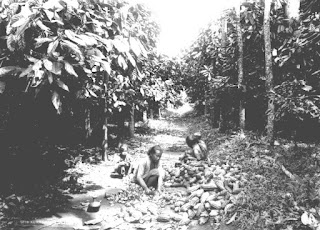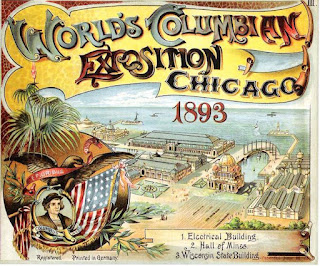CACAO IN COLONIAL TIMES: PRODUCTION
Beginning in the seventeenth century, a growing taste for chocolate across Europe created an increase in demand for cacao. The promise of high profits sparked imperial contests for control. Based on the European economic system of mercantilism, the Spanish, British, French, Dutch, and Portuguese Empires expanded cacao cultivation into areas surrounding the Equatorial region under colonial domain in the Americas. Each empire began to organize cacao cultivation in order to serve the European demand for Latin America’s first cash crop. The evolution of cacao production and labor arrangements in Brazil present a case study for understanding the shift of cacao practices throughout colonial Latin America and the Caribbean.
The nature of cacao production made it labor intensive. Jesuit missionaries used Natives to engage in small-scale systematic production of cacao in Brazil during the sixteenth century. The missionaries, motivated by the nutritional and medicinal properties of cacao coerced their indigenous labor force to harvest the cacao trees growing wild in the Amazon jungle. Organized expeditions went deep into the interior where skillful indigenous workers on meager wages selected and picked only ripe pods. Chattel slaves did the heavy work of getting the pods out of the jungle to the missions. From the mission gardens, cacao was distributed to mission pharmacies to be sold as remedies for ailments, and the sales helped to support missionary activities throughout the seventeenth and eighteenth centuries. Free from government control, by the seventeenth century the Jesuits had monopolized cacao production in the Amazon rainforest and on cultivated land along Amazonia river banks. When a smallpox epidemic in the 1740s decimated the native mission population, the Jesuits turned to African slave labor to continue production. Political tensions between the Jesuits and the Portuguese Crown contributed to the expulsion of the Jesuits from Brazil in 1759. The Jesuit’s forced labor production practices were adopted by small secular plantations and developed into Brazil’s enormously profitable plantation system.
In the middle of the seventeenth century the Viceroy and the Governor General of Brazil had asked the Jesuits for cacao plant cuttings from Amazonia along with directions for proper cultivation in the hinterlands of Bahia. This request set into motion a shift to a different model for the systematic plantation-based cultivation of cacao in Brazil sponsored by the authorities. The Portuguese Crown authorized all Brazilian landowners to plant cacao on their property to expand production of the lucrative crop. White European small-plantation owners compelled Natives and Africans to work on cacao plantations instead of the Jesuit method of gathering the pods in the wild. Early small-scale experiments led to large-scale plantations backed by the Portuguese government that expanded commercial production of cacao using seedlings from Grão Pará that were cultivated and processed by African slave laborers purchased in Salvador.
In 1755, Portuguese authorities created the general Companhia de Commerce e Grão-Pará e Maranhão, a state regulated trade monopoly subsidized by the government to develop and oversee commercial activity. When use of forced native labor ended, the Company increased Middle Passage imports of West African slaves. Due to the labor-hungry nature of cacao harvesting, children, strong men, pregnant women, and the elderly worked from cradle to grave on large plantations. Overseers divided the Africans into gangs and working units organized by specialty to plant, pick, and process cacao, or to maintain the infrastructure of the plantation. As the commercial cacao market expanded around Bahia, historians estimate that nearly ten percent of the volume of Middle Passage Brazilian slave trade became cacao plantation workers in Brazil, a total of nearly four-hundred-thousand Africans. Due to the toil of West African slaves, by the late eighteenth century large-scale Brazilian plantations were exporting over one-thousand tons of cacao per year.
Brazil’s evolution from small- to large-scale cacao production and its shift from indigenous workers to full engagement in the African slave trade presents a case study for understanding the changes in cacao practices in the Americas. From the Jesuits’ use of indigenous labor to harvest cacao in the Amazon wild, to European import of Africans slaves to cultivate and produce cacao on large plantations around Bahia, Brazil—like the rest of the Americas—had altered practices to meet the growing demand for cacao. Going into the nineteenth century, the African slave trade and its connection to cacao revenue led to the accumulation of capital that became an important engine on the road to the Industrial Revolution and expansion of capitalism.
Bibliography:
HIS429. Lecture 4. Cacao in Colonial Times: Production
Walker, Timothy. “Establishing Cacao Plantation Culture in the Atlantic World.” In Chocolate, 543–58. Hoboken, NJ, USA: John Wiley & Sons, Inc, 2009.



Comments